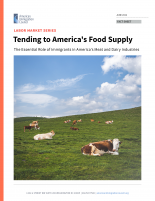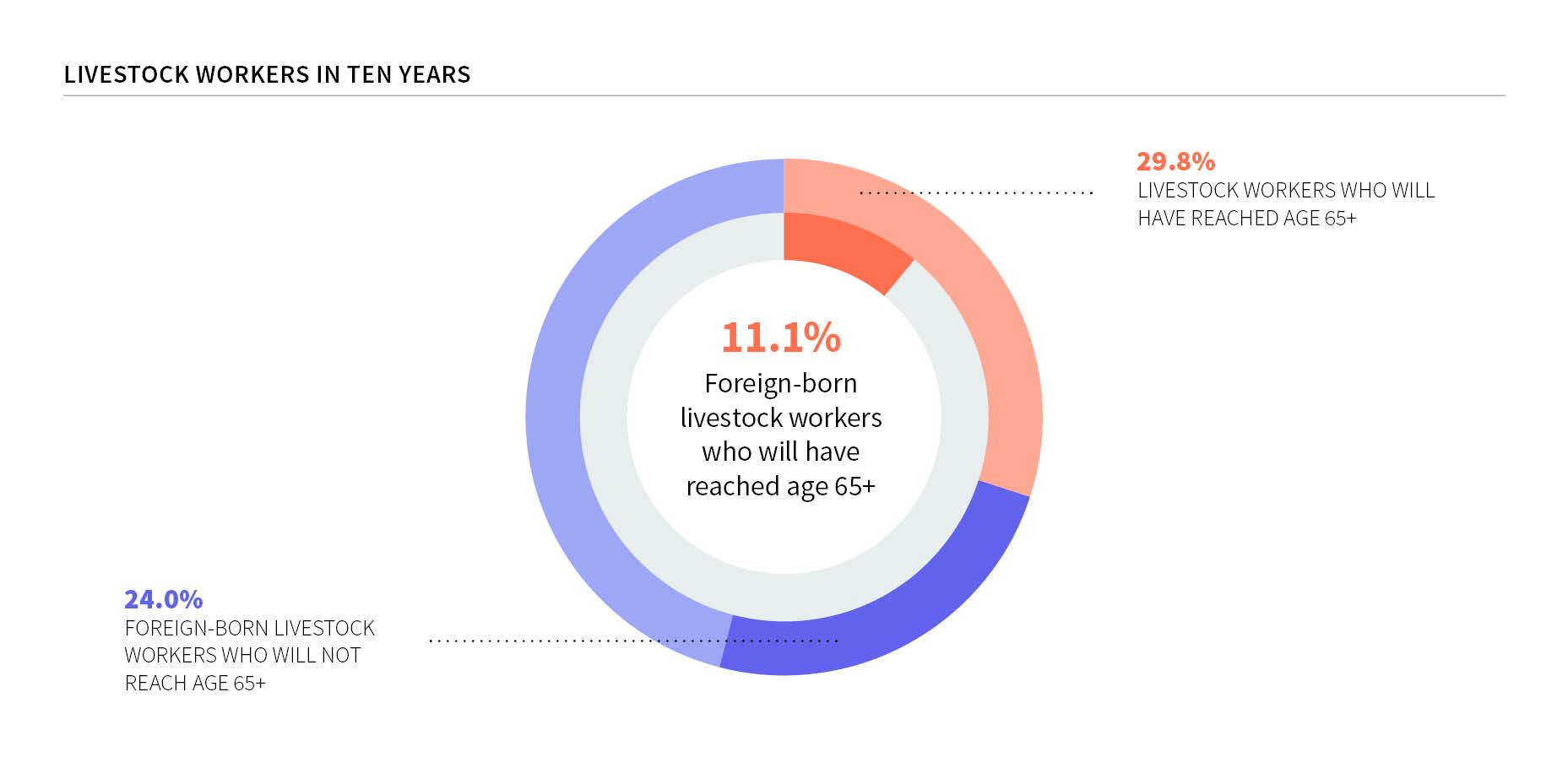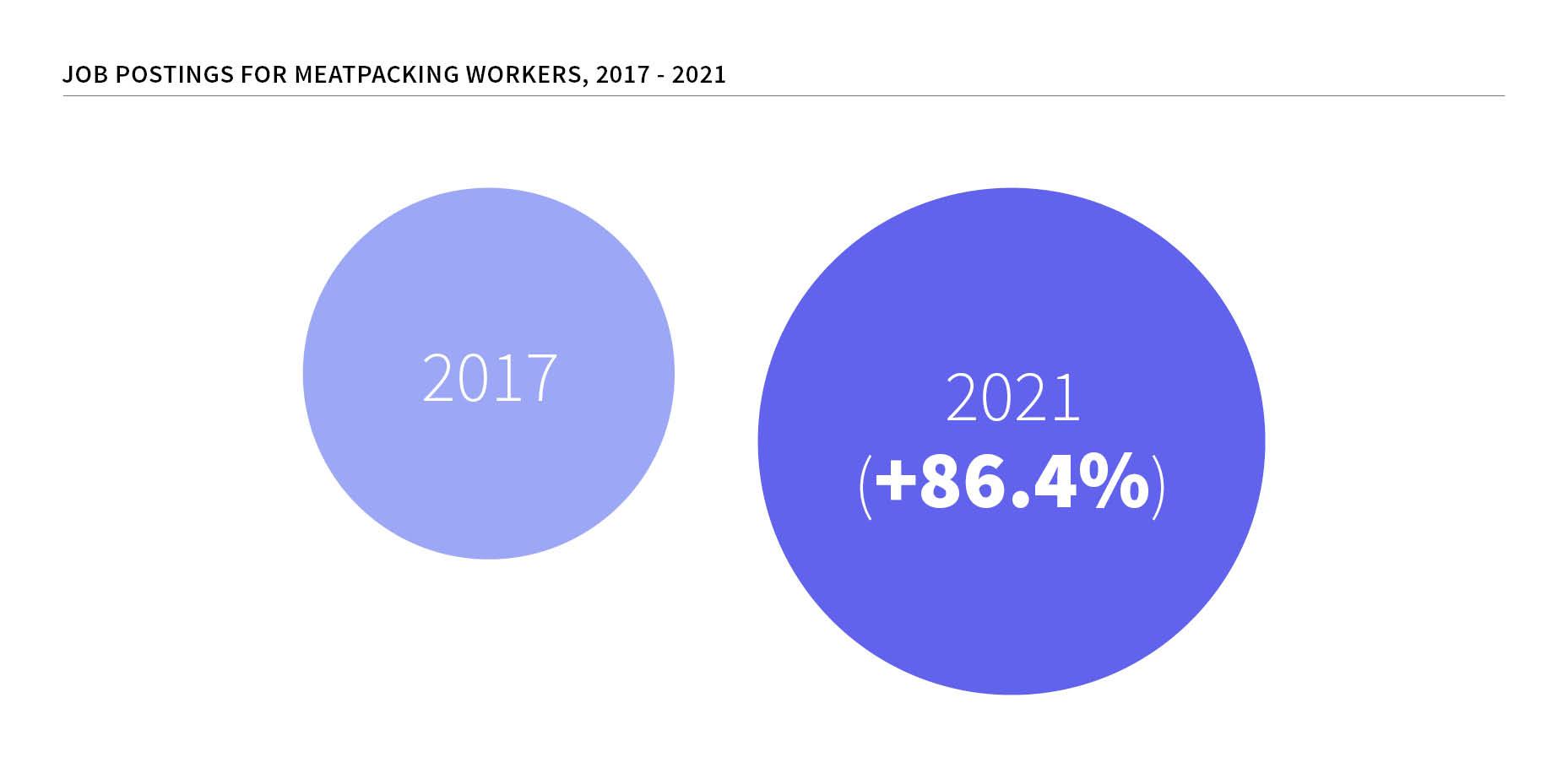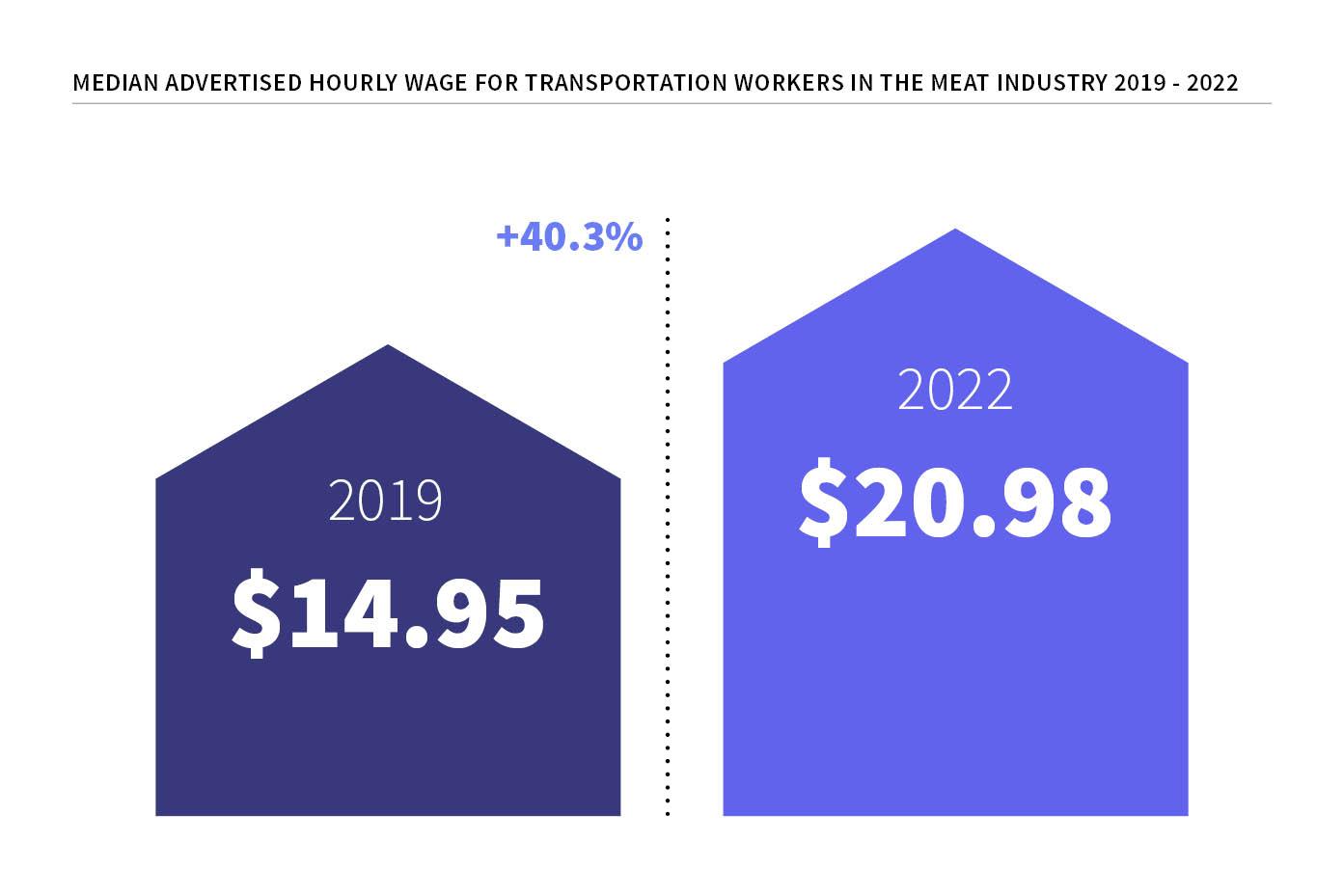- Fact Sheet
Tending to America's Food Supply
The Essential Role of Immigrants in America's Meat and Dairy Industries
Published
Key findings:
-
Even before the pandemic, the meat and dairy industries struggled to hire enough workers.
The current national labor shortage has worsened the problem, and it's causing meat and dairy prices to rise between 4.5 and 7.0 percent.
-
These price increases are due in part to higher wages employers must offer to attract workers.
From 2019 to 2022, the median wage for meat and dairy industry workers* increased 33.7 percent, from $14.95 to $20.00 per hour. This far outpaces U.S. median wage which increased from $20.11 to $21.51 per hour, or 7.4 percent during the same period.
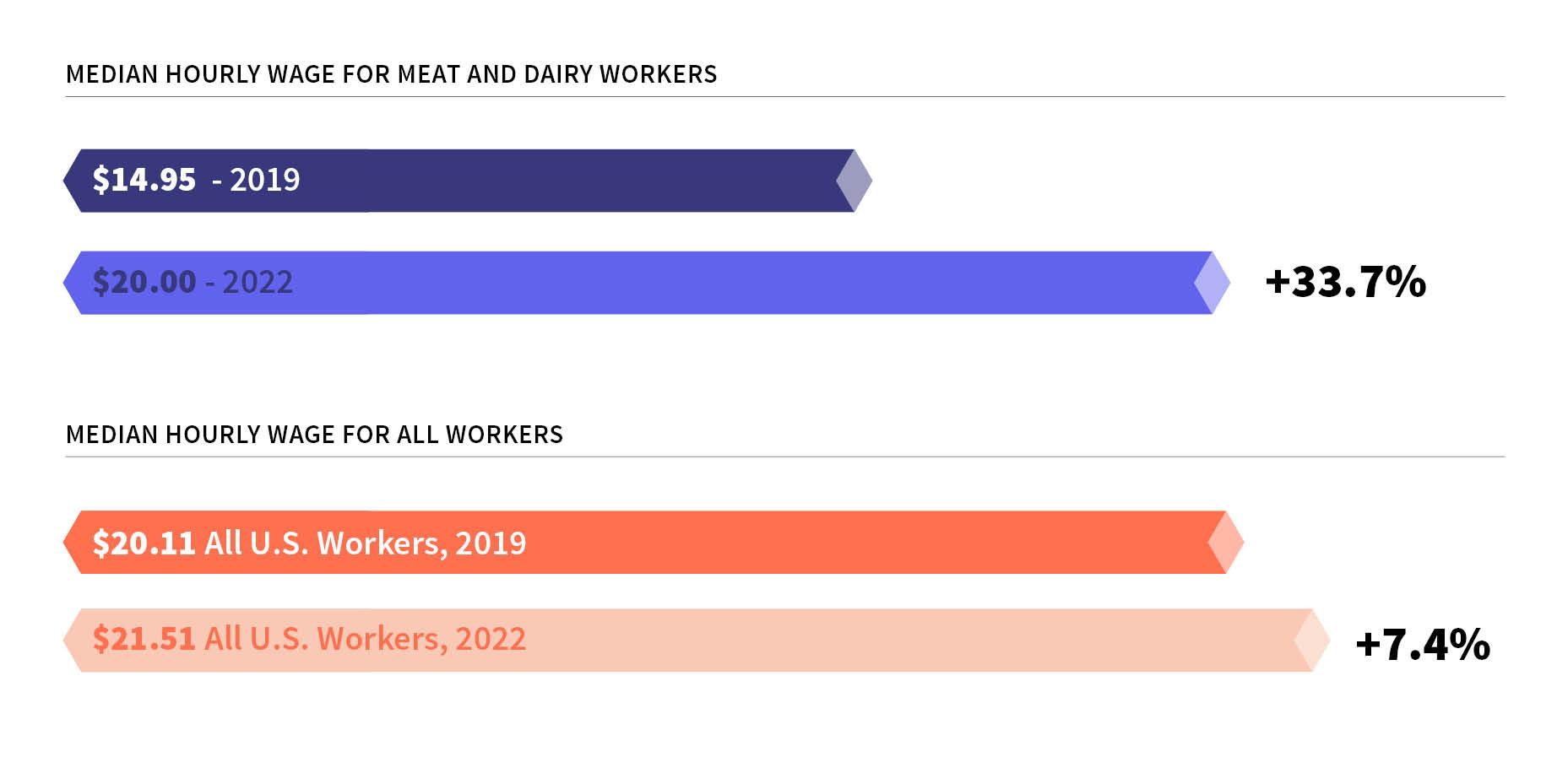
-
Transportation plays a vital role in the production and pricing of meat and dairy products.
Since the start of the pandemic, advertised wages for meat and dairy truck drivers have increased nearly 40 percent due to high demand. Already, one in four of the industries’ truck drivers are immigrants.
-
Foreign-born workers are essential to America’s food supply.
As many workers —both U.S.- and foreign-born —reach retirement age and leave the workforce, the meat and dairy industries will be increasingly hard-pressed to find enough workers. While meat and dairy employers rely on the H-2A and H-2B visa programs to fill jobs with temporary foreign workers, these visa programs are seasonal and do not meet the needs of what are non-seasonal industries.
In the recovery from the pandemic, more people have been looking to spend money on goods and services. However, disrupted supply chains and other geopolitical events have limited the ability of suppliers to meet consumers’ demand. On top of this, in the United States, a labor shortage is making this imbalance worse, further increasing the price of goods and services to levels not seen in decades. The agricultural sector has experienced a labor shortage for the past two decades, but the current labor crisis, which is forcing employers to pay higher wages to attract workers, has increased production costs even more. These higher costs have forced some farmers and meatpacking plants to close, decreasing the supply of meat and dairy products and leading to yet higher prices due to increased demand. Industry closures also threaten to financial harm many rural communities that rely on agricultural production for economic growth.
The current national labor shortage is the result of two factors: an increase in retirements as the baby boom generation reaches retirement age, and lower labor participation rates since the pandemic. These national trends have exacerbated an existing labor shortage in rural America. As noted, this has led to increased production costs and higher food prices. The USDA’s Food Price Outlookpredicts that from 2019 to 2022 meat prices will increase by 4.5 to 5.5 percent and dairy prices will increase by 6.0 to 7.0 percent.
Data from Emsi/Burning Glass labor market analytics highlights the sharp increase in the wages of meat and dairy workers since the start of the pandemic. Over the past three years, the median advertised online wage for workers in the meat and dairy industries has risen 33.7 percent, from $14.95 to $20.00 per hour. By comparison, the national median advertised online salary for all workers increased by just 7.4 percent in three years, rising from $20.03 to $21.51 per hour.
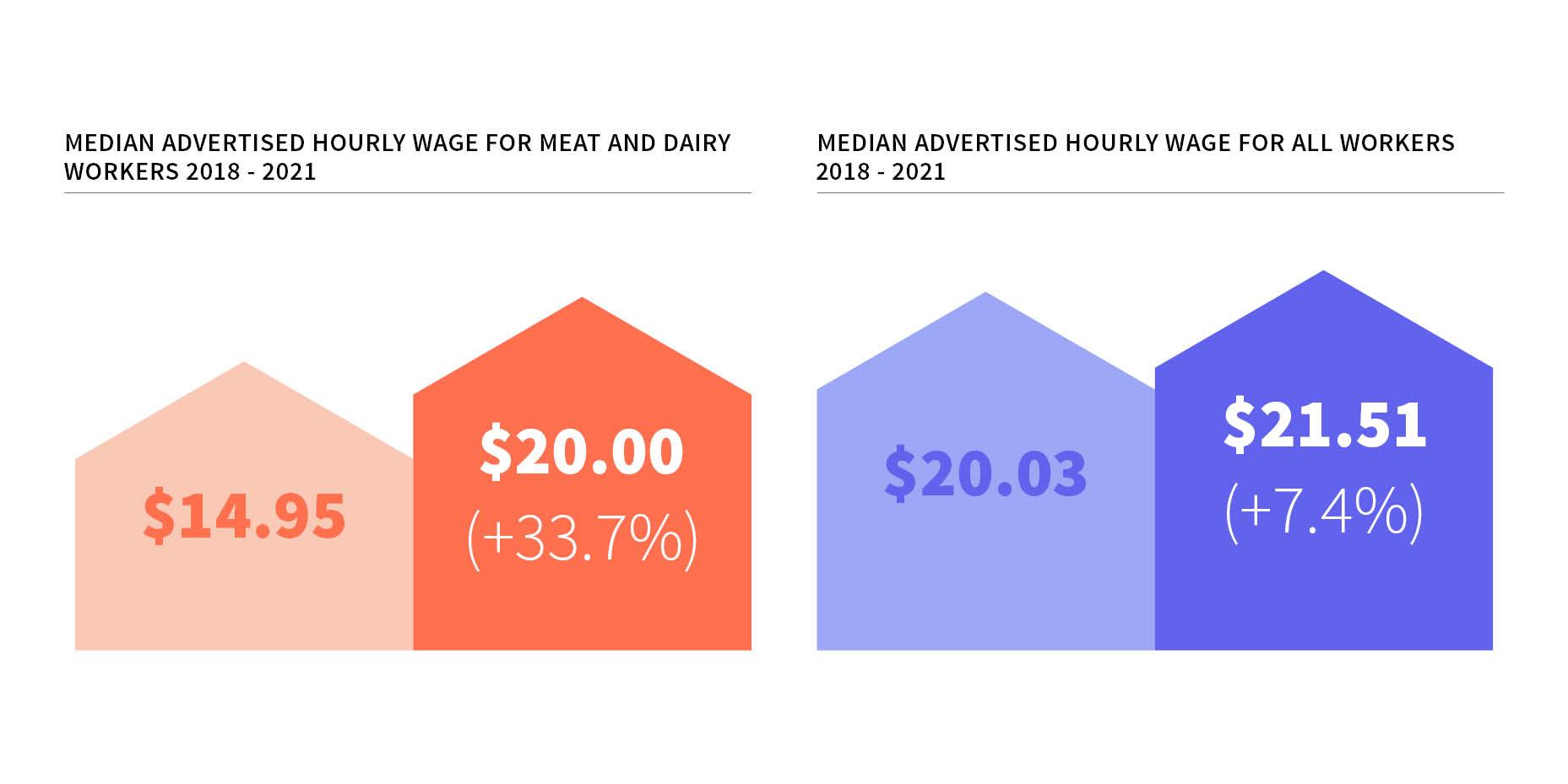
To help mitigate labor costs, many farmers and meat processing plants use H-2A and H-2B visas—visa programs that allow employers to hire foreign workers for seasonal labor. The agricultural industry relies heavily on both of these limited visa programs to get the workers it needs, with the number of visas issued increasing over the past decade.
Meat employers use both the H-2A and H2-B visa programs to find workers for positions they are unable to fill with American workers. The H-2A visa, for temporary agricultural workers, is used to hire workers to do things like tend to livestock or maintain the machinery and buildings on the farm. The H-2B visa, for temporary non-agricultural workers, is used to hire workers to do things like butcher meat or inspect and clean all cuts of meat and machinery according to federal regulations. Dairy farms, which require year-round help, do not typically benefit from the H-2A or H-2B visa programs, which only allow employers to bring in agricultural workers for a season.
In fiscal year 2021, meat and dairy employers requested a combined total of 34,245 H-2A and H-2B workers. Of those, the U.S. Department of Labor certified 32,071, a 93.7 percent certification rate. More than 93.8 percent of those 32,071 temporary workers were on H-2A visas; the remainder were working mostly at meat packing plants on H-2B visas. Most H-2A visa holders work in crop production; however, almost one in ten H-2A visa holders work in the meat industry. H-2B visa holders work predominantly in non-agriculture industries, such as landscaping, forestry, and recreation. As such, only 1.0 percent of H-2B visa holders work specifically in the meat and dairy industries.
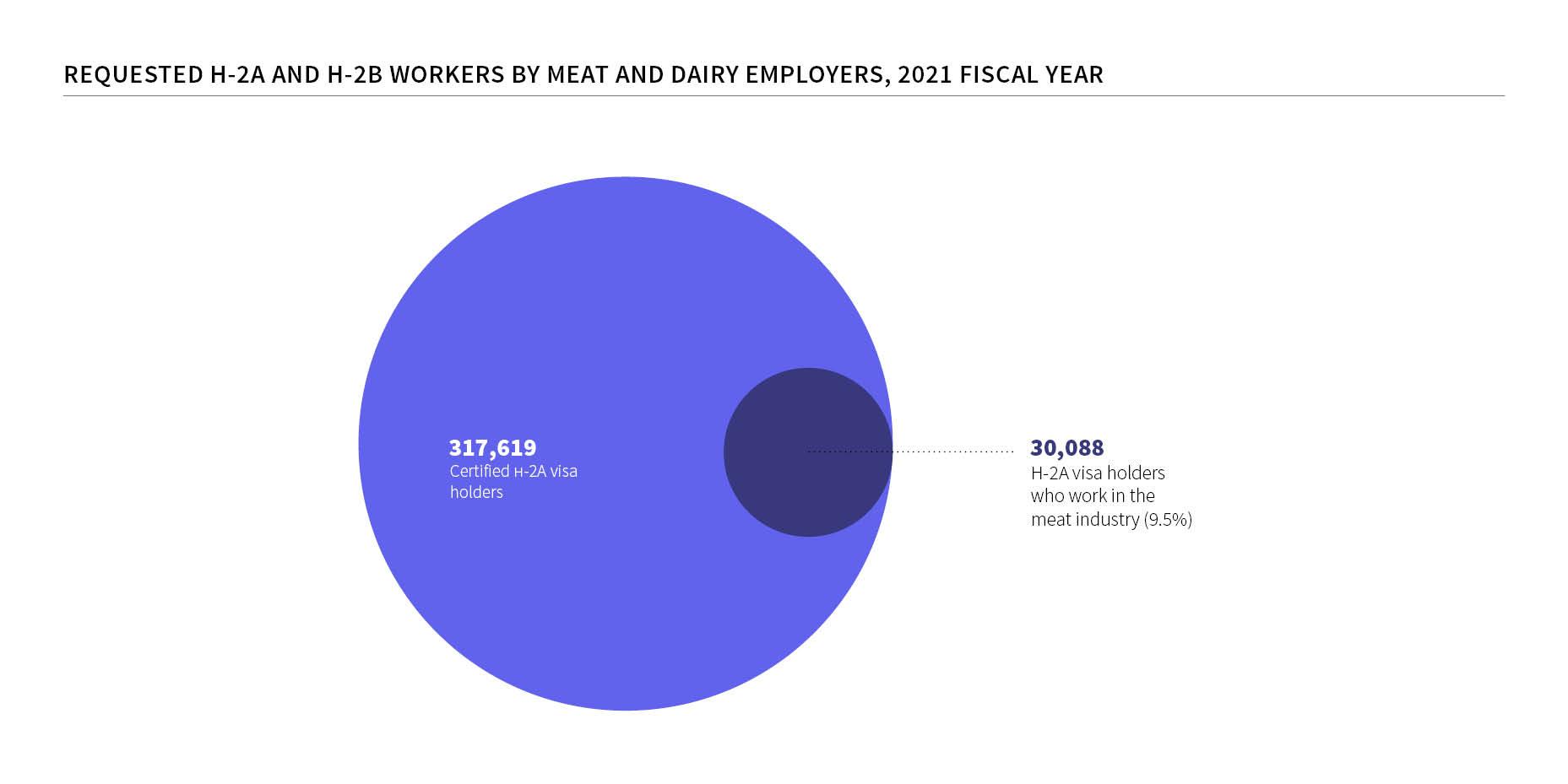
Meat and dairy production is labor intensive and requires a wide range of workers, including farmers, ranchers, laborers, butchers, packagers, and truck drivers. One indicator of the growing demand for meat and dairy workers is the growing number of online job postings for such jobs. From 2019 through 2021, the number of unique online job postings for these workers increased by 64.2 percent nationwide. Metropolitan areas with the highest demand for meat and dairy workers included Houston, Omaha, San Antonio, Austin, and Los Angeles; states with the highest number of postings included Texas, California, Iowa, and North Carolina.

Livestock Workers
More than 90,000 workers breed, raise, and tend to animals on farms, ranches, livestock yards, and animal confinement facilities across the country. One in five of these workers, or 20 percent, are foreign-born, a significantly higher percentage than the national share of foreign-born workers for all industries combined, which is 17.4 percent. Many livestock workers are also approaching retirement age. In the next ten years, 29.8 percent of livestock workerswill have reached the age of 65. Most of these older workers are U.S.-born; only 11.1 percent are foreign-born. Of the workers who will not reach age 65 in the next ten years, almost one in four (24.0 percent) are foreign-born. As such, the meat industry will increasingly rely on immigrant workers to take care of the animals that eventually reach America’s kitchen tables.
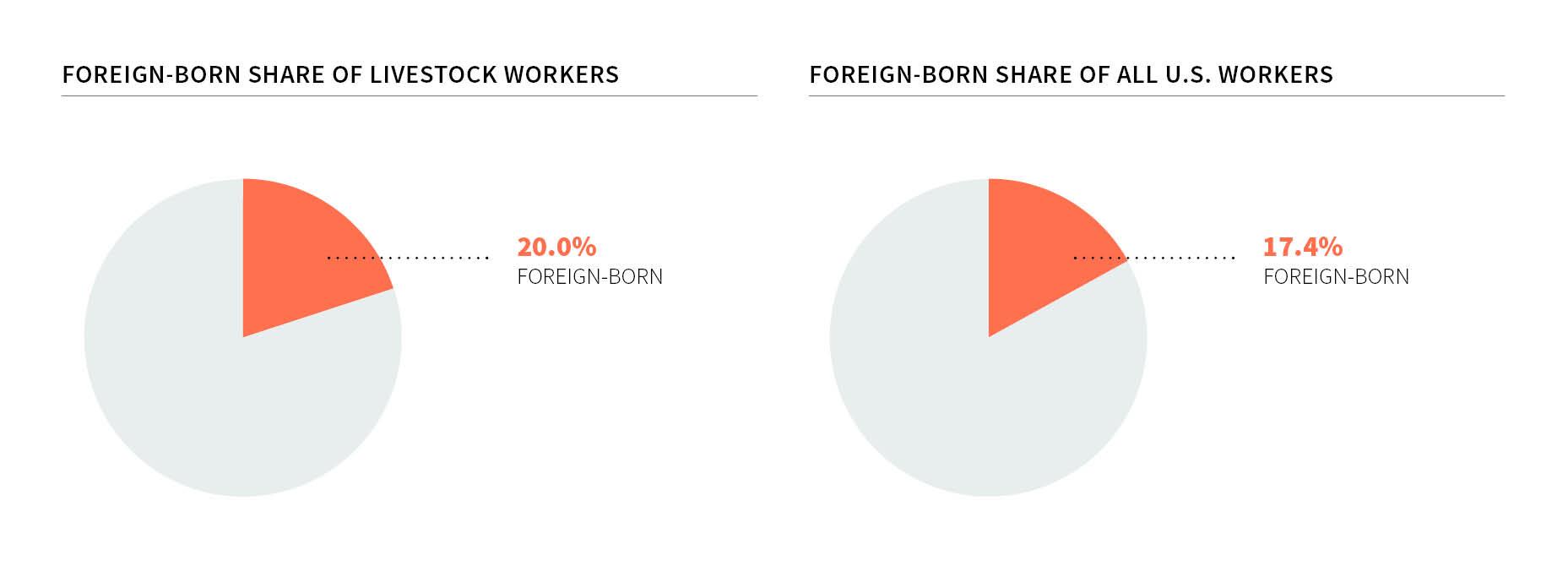
Meatpacking Workers
Historically, the U.S. meatpacking industry has relied heavily on immigrant workers. In the 1880s, the opening of stockyards and meatpacking houses in South Omaha, Nebraska, attracted many Eastern European immigrants to the city and established Nebraska as “the Beef State.” During the 1990s, many poultry plants started recruiting heavily from immigrant communities poultry plants started recruiting heavily from immigrant communities in response to increased union organizing among U.S.-born workers. During the early days of the pandemic, the share of meatpacking workers who were foreign-born was 45.4 percent— 28 percentage points higher than the average share for all industries combined. Many of these meatpacking workers bore the brunt of COVID-19 outbreaks due to the crowded factory floors and limited, or no, allowed time off.
As with many occupations in 2021, a low labor participation rate among meatpackers has increased the demand for workers. This can be seen in the significant increase in online job postings. From 2017 to 2021, the number of unique online job postings for meatpacking workers increased by 86.4 percent, according to Ems/Burning Glass. For an industry already suffering from labor shortages before the pandemic, the Great Resignation has exacerbated supply shortages and, in turn, raised meat prices. To mitigate the labor shortage, meat producers have called for the federal government to expand the H-2B visa program to allow year-round visas in addition to the seasonal visas allowed today.
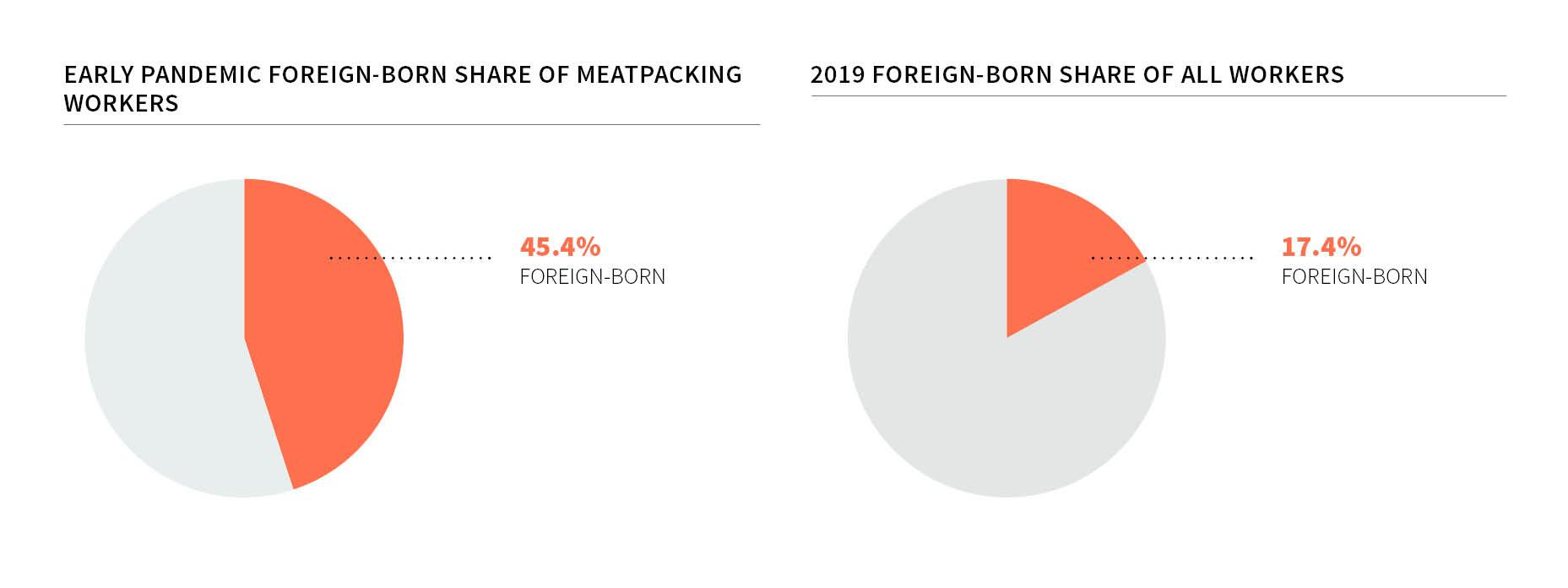
Transportation Workers
More than one in four transportation workers in the meat industry are foreign-born (26.0 percent), a higher share than that of all transportation workers combined (19.1 percent). Transportation workers are clearly vital to the meat industry, bringing animals from ranches to feed lots and packing plants, and meat products to stores. The current labor shortage has significantly increased the demand for transportation workers. Both the number of online job postings and advertised wages have risen. From 2019 to 2021, the number of unique online job postings for transportation workers in the meat industry doubled (by 115.0 percent). In addition, the median advertised wage in those job postings increased by 40.3 percent, from $14.95 per hour in April 2019 to $20.98 per hour in March 2022.
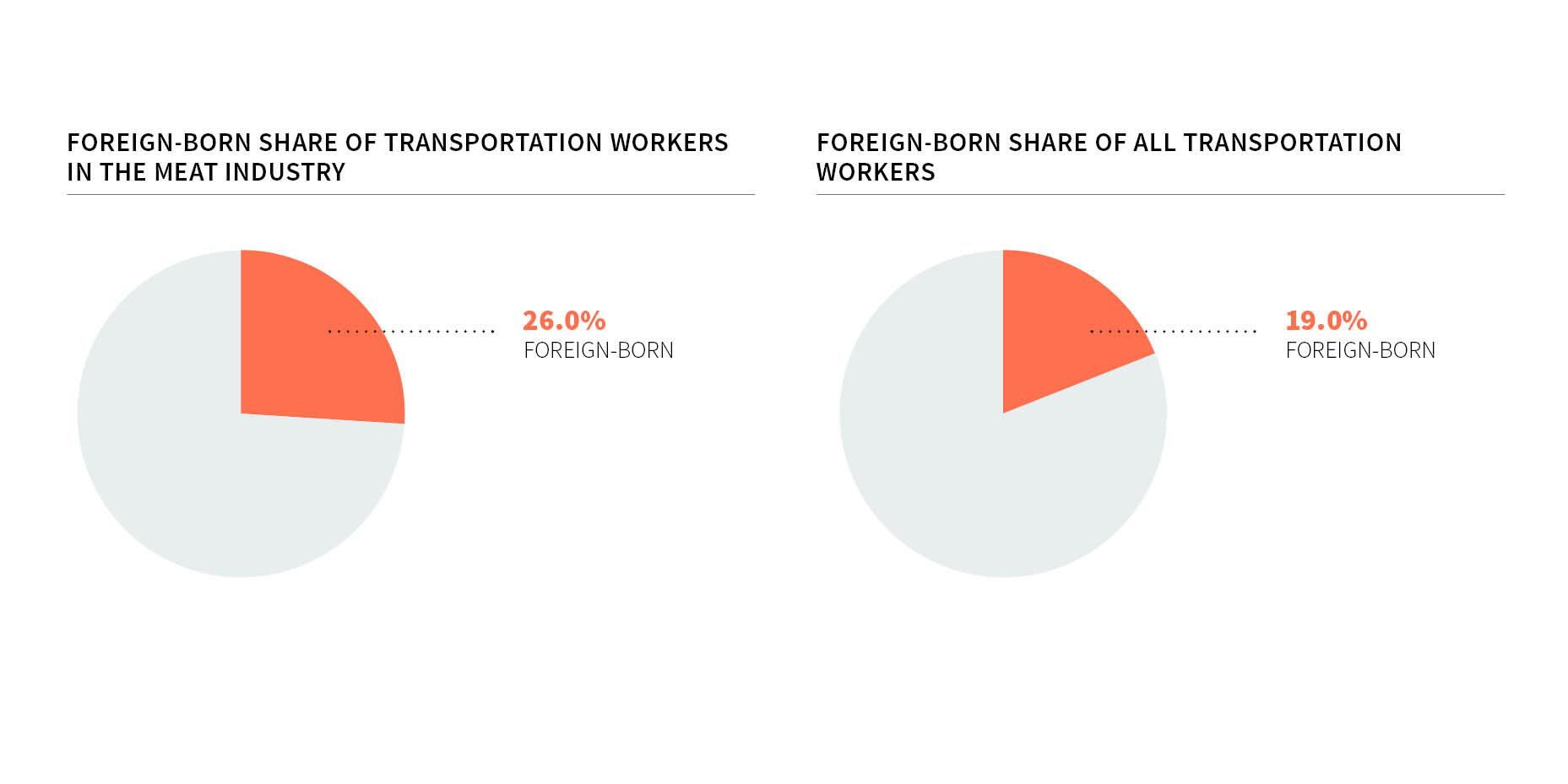
Transportation workers provide a vital link from the farm to the plant and the store. Higher transit costs mean higher prices at the store. To help mitigate the labor shortage, the Biden administration in 2021 announced plans to expand access to trucking occupations to, including among underrepresented individuals such as veterans and women.
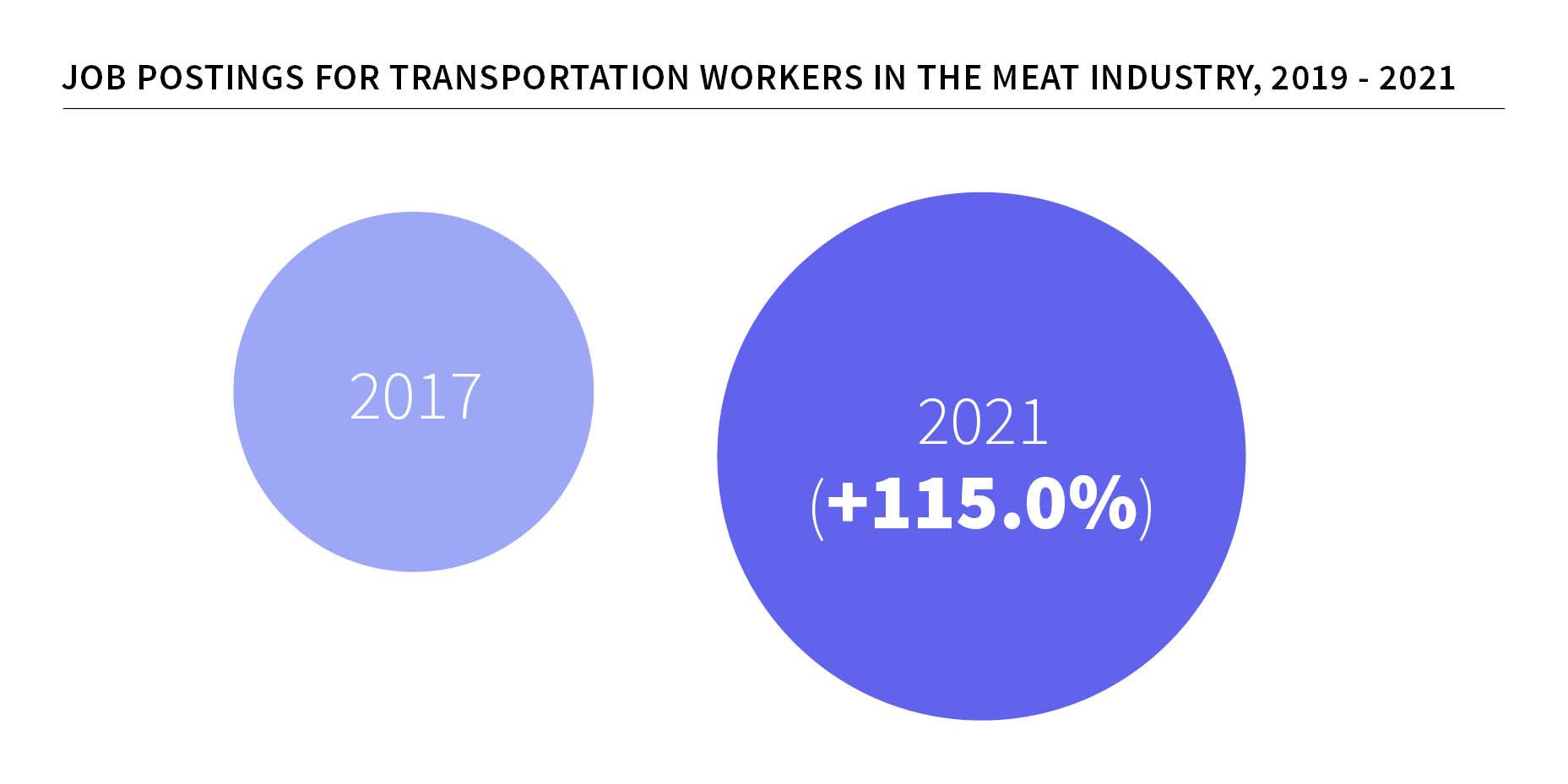
Dairy Workers
Many dairy farmers rely on immigrant workers—often undocumented—to milk and tend to the cows. Thanks in part to the rural labor shortage, immigrants have become the backbone of America’s dairy workforce. A Texas A&M AgriLife research study found that retail milk prices would nearly double if farmers lost foreign-born workers. According to the 2019 American Community Survey (five year), nearly one in five workers on dairy farms are immigrants. However, other studies have found the share of immigrants in the dairy industry to be higher. For instance, the Texas A&M AgriLife study found that 51.2 percent of dairy workers were immigrants.
The labor shortage has not only increased wage and production costs, but it has also dramatically decreased the number of licensed dairy herds in the United States. The USDA reported that there were 51,291 dairy herds in the United States in 2011. A decade later, it reported 29,858, a 41.7 percent decrease. The dairy industry, like other agricultural industries, is moving toward larger and fewer operations. The number of smaller, family-owned operations is dropping, putting further financial strains on rural economies.
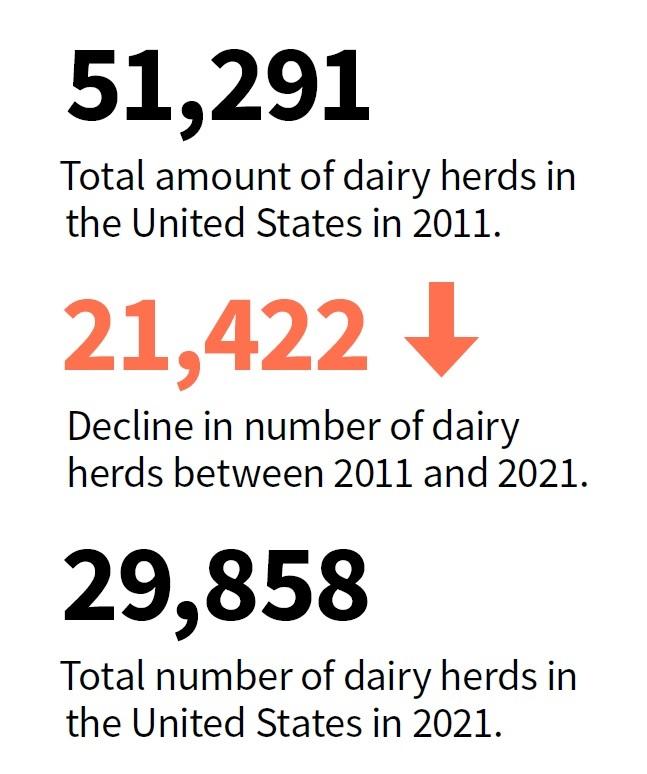
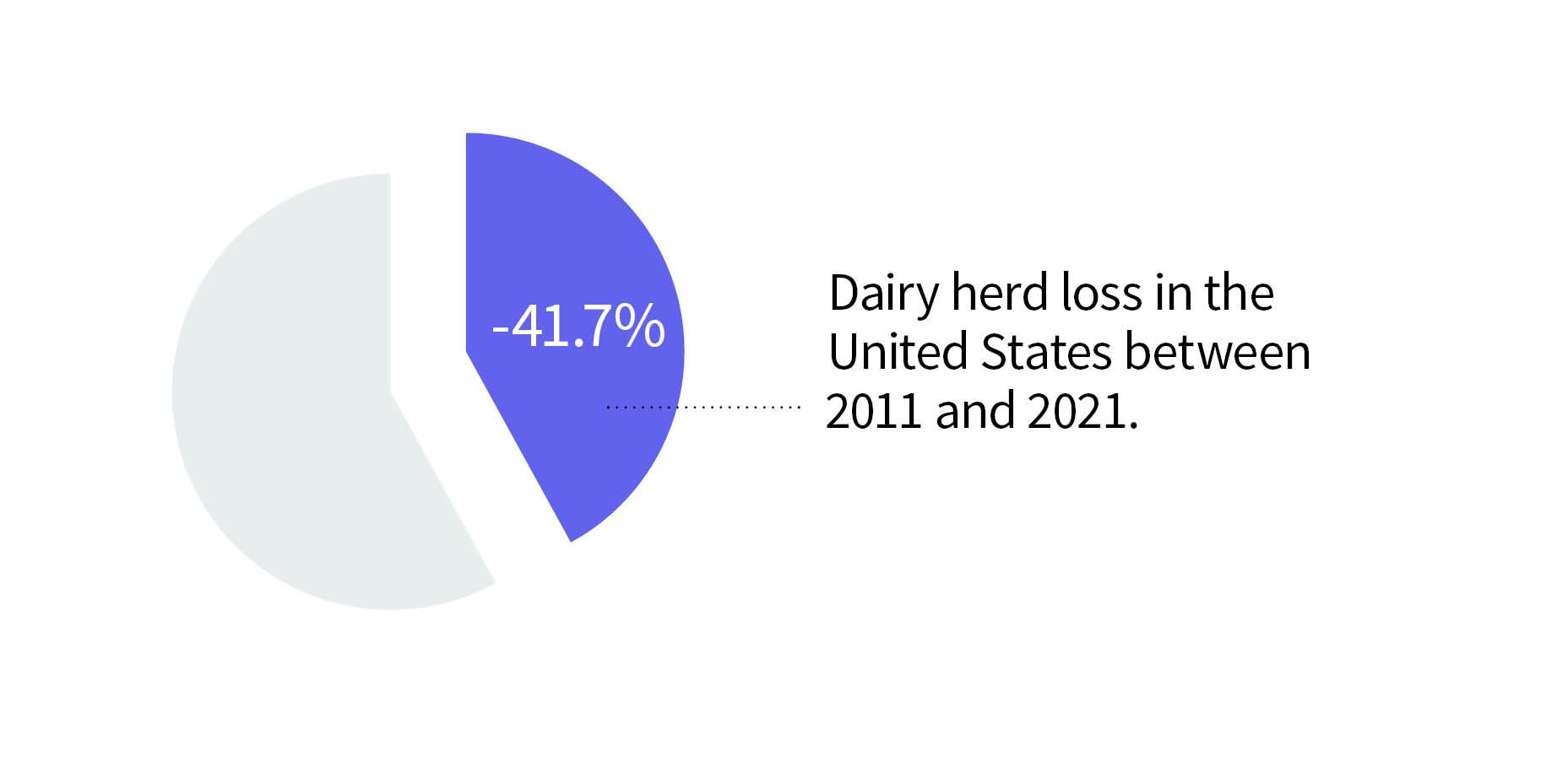
Conclusion
The labor crisis in the meat and dairy industries highlights the important role that immigrant workers play in producing America’s food. The labor shortage has led to increased production costs for farmers and employers and higher food prices for American shoppers. If the United States is to stabilize its food workforce—and thus stabilize prices—it must consider expanding temporary work visa programs and implementing other long-term reforms – including providing a path to citizenship for many of the undocumented farmworkers in the U.S. today – to address the labor needs of the meat and dairy industries.
*Meat and dairy workers include those who work with livestock (ranchers, breeders, animal caretakers), process meat (butchers and meat packers), transport animals and products (truck drivers), and dairy workers who take care of the cattle and process the milk for distribution.
Help us fight for immigration justice!
The research is clear – immigrants are more likely to win their cases with a lawyer by their side. But very few can get attorneys.
Introducing the Immigration Justice Campaign Access Fund.
Your support sends attorneys, provides interpreters, and delivers justice.

Immigration Justice Campaign is an initiative of American Immigration Council and American Immigration Lawyers Association. The mission is to increase free legal services for immigrants navigating our complicated immigration system and leverage the voices and experiences of those most directly impacted by our country’s immigration policies to inform legal and advocacy strategies. We bring together a broad network of volunteers who provide legal assistance and advocate for due process for immigrants with a humane approach that includes universal legal representation and other community-based support for individuals during their immigration cases.

